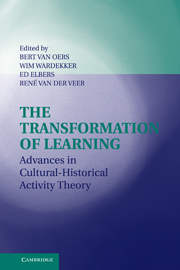Book contents
- Frontmatter
- Contents
- List of Contributors
- Preface
- INTRODUCTION
- SECTION ONE TENETS OF ACTIVITY THEORY
- Introduction to Section One: Exploring Vygotsky's Legacy: The Meaning of Mediation
- 2 Multiple Readings of Vygotsky
- 3 Exploring the Links between External and Internal Activity from a Cultural-Historical Perspective
- 4 Reflections on Points of Departure in the Development of Sociocultural and Activity Theory
- 5 Language in Cultural-Historical Perspective
- 6 The Formation Experiment in the Age of Hypermedia and Distance Learning
- 7 Constructivism and Meaning Construction
- 8 Subject, Subjectivity, and Development in Cultural-Historical Psychology
- SECTION TWO IDENTITY, DIVERSITY, AND INCLUSION
- SECTION THREE DYNAMICS OF ACTIVITY AND THE VARIATIONS OF LEARNING
- Index
- References
4 - Reflections on Points of Departure in the Development of Sociocultural and Activity Theory
Published online by Cambridge University Press: 25 August 2009
- Frontmatter
- Contents
- List of Contributors
- Preface
- INTRODUCTION
- SECTION ONE TENETS OF ACTIVITY THEORY
- Introduction to Section One: Exploring Vygotsky's Legacy: The Meaning of Mediation
- 2 Multiple Readings of Vygotsky
- 3 Exploring the Links between External and Internal Activity from a Cultural-Historical Perspective
- 4 Reflections on Points of Departure in the Development of Sociocultural and Activity Theory
- 5 Language in Cultural-Historical Perspective
- 6 The Formation Experiment in the Age of Hypermedia and Distance Learning
- 7 Constructivism and Meaning Construction
- 8 Subject, Subjectivity, and Development in Cultural-Historical Psychology
- SECTION TWO IDENTITY, DIVERSITY, AND INCLUSION
- SECTION THREE DYNAMICS OF ACTIVITY AND THE VARIATIONS OF LEARNING
- Index
- References
Summary
In this chapter I attempt to clarify, elaborate, compare, and contrast sociocultural approaches to learning. After addressing the tension between accounts of mediated action and activity (or semiotic and activity-based accounts), I reflect on the notion of tool or artefact as mediator between individual and social and suggest that this requires further clarification. My next step is to address the issue of the production of tools or artefacts in contexts, asking how we understand the production of tools or artefacts in terms of the social relations that obtain in the circumstances in which they were produced. Lastly, I discuss the need to extend the analysis beyond words and ask how we can develop methodologies that enable us to explore effects of activity that is mediated by and through nonverbal means. I illustrate this section through reference to empirical work.
THE TENSION BETWEEN ACCOUNTS OF SEMIOTIC AND ACTIVITY-BASED MEDIATION
The concept of “mediation” opens the way for the development of a nondeterministic account in which mediators serve as the means by which the individual acts upon and is acted upon by social, cultural, and historical factors. There is considerable tension and debate as to the nature of such factors. Some approaches have tended to focus on semiotic means of mediation (Wertsch, 1991), whereas others have tended to focus more on activity itself (Engeström, 1993). Engeström argues that the positioning of Leontiev, one of the progenitors of activity theory, as someone who took no account of semiotic mediation was and is erroneous.
- Type
- Chapter
- Information
- The Transformation of LearningAdvances in Cultural-Historical Activity Theory, pp. 58 - 75Publisher: Cambridge University PressPrint publication year: 2008
References
- 4
- Cited by



